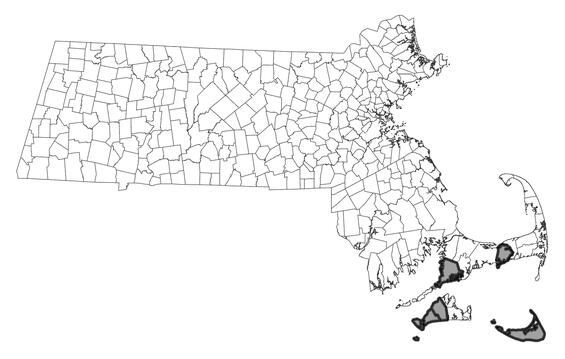- Scientific name: Hydrocotyle vertilcillata Thunb
- Species of Greatest Conservation Need (MA State Wildlife Action Plan)
- Threatened (MA Endangered Species Act)
Description
Saltpond pennywort, Hydrocotyle verticillata, is a member of the parsley family (Apiaceae). This small (10-15 cm [4-6 in] tall), delicate, aquatic herb has orbicular leaves up to 6 cm (2 1/4 in) in diameter, commonly with 8 to 14 shallow lobes. There is no central, erect stem; rather, leafstalks and flowering shoots are produced at intervals along subsurface stems. The inflorescence is a simple spike up to 15 cm (6 in) tall, with 3 to 7 few-flowered whorls of 2 to 7 mostly sessile flowers each.
H. umbellata (water pennywort) is very similar to saltpond pennywort in size and leaf shape but the flowers and fruits differ. H. umbellata usually has only a single whorl (though occasionally up to 3 whorls) of 10 to 35 flowers on pedicels all longer than the flower is long. Its fruit, a schizocarp, is 2-3 mm (0.08-0.12 in) long, and is deeply notched or cordate at the base. In contrast, saltpond pennywort, has schizocarp that is rounded or shallowly indented at the base, and is 3-4 mm (0.12-0.16 in) wide. (Haines, 2025 in preparation).
Life cycle and behavior
Flowers are produced when plants are stranded, July-September.
Population status
Saltpond pennywort is listed under the Massachusetts Endangered Species Act as threatened. All listed species are protected from killing, collecting, possessing, or sale and from activities that would destroy habitat and thus directly or indirectly cause mortality or disrupt critical behaviors. In Massachusetts, this species has always been rare, presumably because of climatic limitations northward. There are 16 populations that have been verified as extant since 1999 in Barnstable, Dukes and Nantucket Counties. another 10 populations have not been relocated in the last 25 years.
Distribution and abundance
This species ranges along the coastal plain and piedmont from Massachusetts to Florida and Texas. It is also scattered westward to Oklahoma, Missouri, California, Utah, and Nevada. In addition, it is found in tropical America.

Distribution in Massachusetts. 2000-2025. Based on records in the Natural Heritage Database.
Habitat
Saltpond pennywort grows along sandy to peaty margins (salt-pond marsh) of brackish ponds very near the ocean. Usually, these ponds are separated from the ocean by just a narrow sand barrier. Associated species may include Spartina pectinata (prairie cord-grass), Schoenoplectus americanus (Olney’s threesquare), Chenopodium glaucum (oak-leaved goosefoot), Pluchea odorata (saltmarsh fleabane), and Ranunculus cymbalaria (seaside crowfoot).
Healthy habitats are vital for supporting native wildlife and plants. Explore habitats and learn about conservation and restoration in Massachusetts.
Threats
The primary threat to Hydrocotyle verticillata is sea level rise. This species is known from ponds that have an influx of freshwater from the land, with occasional storm, king tide or anthropogenic openings allowing the ocean to overflow into the pond, making it brackish. With sea level rise, the land barrier that currently prevents the pond from connecting to the ocean could break down converting the habitat to saltwater. If the salt pond water levels rise prior to the loss of the barrier beach, there will be limited habitat for H. verticillata along the shoreline, as it prefers to grow in open areas without shade. As this is a species growing along sandy shores of salt ponds, trampling by people is also a possibility. Populations of the invasive Phragmites australis (common reed) can also threaten this species, shading it out.
Conservation
The populations of H. verticillata tend to be long lasting, as long as the barrier beaches protecting this species' ponds are not lost due to sea level rise. If the barriers remain intact, surveys for this threatened species only need to occur every five to ten years. The best time to survey for this species is when the plants are in flower or seed, late July through September.
As with many rare species, the exact ecological needs of H. verticillata are not well understood. If trampling is an issue with the specific population, it should be protected by excluding access and through signage. All active management of rare plant populations (including invasive species removal) is subject to review under the Massachusetts Endangered Species Act and should be planned in close consultation with the MassWildlife's Natural Heritage & Endangered Species Program.
Research is needed to determine whether this plant can be grown in a nursery or garden setting for purposes of reintroductions. Questions about seed germination and seed storage over winter will need to be answered. As sea-level rise may create new habitat while at the same time isolating and destroying current populations, this strategy for reintroductions could prove useful to long-term conservation of this species.
References
Haines, Arthur. in preparation. Flora Novae Angliae - a Manual for the Identification o of Naive and Naturalized Higher Vascular Plants of New England, second edition.
NatureServe. 2025. NatureServe Network Biodiversity Location Data accessed through NatureServe Explorer [web application]. NatureServe, Arlington, Virginia. Available https://explorer.natureserve.org/. Accessed: 5/23/2025.
POWO (2025). Plants of the World Online. Facilitated by the Royal Botanic Gardens, Kew. Published on the Internet; https://powo.science.kew.org/ Accessed: 3/4/2025.
Young, Steve, New York Natural Heritage Program. 2009. "Weird Whorls: Hydrocotyle Identification on Long Island" in Long Island Botanical Society The Quarterly Newsletter. Vo. 19, No. 2. pp 12-14.
Contact
| Date published: | April 29, 2025 |
|---|